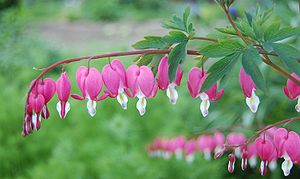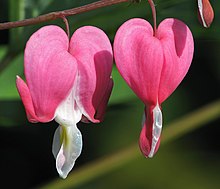crying heart
| crying heart | ||||||||||||
|---|---|---|---|---|---|---|---|---|---|---|---|---|

Bleeding heart ( lamprocapnos spectabilis ) |
||||||||||||
| Systematics | ||||||||||||
|
||||||||||||
| Scientific name of the genus | ||||||||||||
| Lamprocapnos | ||||||||||||
| Final | ||||||||||||
| Scientific name of the species | ||||||||||||
| Lamprocapnos spectabilis | ||||||||||||
| ( L. ) Fukuhara |
The bleeding heart ( Lamprocapnos spectabilis ), also called two-colored heart flower , heart stick , flaming heart or Marienherz , is the only species of the genus Lamprocapnos Endl. of the poppy family ( Papaveraceae ) and a popular ornamental plant . It is poisonous plant of the year 2017.
features
The bleeding heart is a perennial , herbaceous plant that reaches heights of 50 to 90 centimeters. It forms a Pleiokorm turnip. The leaves are 20 to 40 centimeters long and 14 to 20 centimeters wide. They are 2 to 3 times pinnate. The end sections are lobed to pinnate and 2 to 3 centimeters long.
The flowers are heart-shaped at the base and measure 20 to 27 × 18 to 22 millimeters. Depending 8 to 11, often 3 to 15 flowers are in a einseitswendig overhanging grape arranged. The outer petals are mostly pink, less often white, and their tips are protruding or bent back.
The flowering period extends from May to June, rarely beginning in April.
The number of chromosomes is 2n = 16.
Occurrence
The bleeding heart occurs in Korea as well as in the north and west of the People's Republic of China in light, moist mountainous forests at altitudes of 30 to 2400 meters.
Although the species is a very common garden plant, it rarely goes wild. There are few stable neophytic occurrences.
Systematics
The bleeding heart was long (as Dicentra spectabilis ) part of the genus of the heart flowers ( Dicentra ), with whose representatives it mainly has the flower shape in common. However, the different anatomy of the seed coat suggested that the species should be separated from the genus. A molecular genetic study from 1997 proved the independence. Since then it has been assigned to the monotypic genus Lamprocapnos as Lamprocapnos spectabilis .
use
The bleeding heart is widely used as an ornamental plant in borders and cottage gardens and as a cut flower. Due to its popularity it is subject to many breeding; The result of this is, for example, the white flowered variety Lamprocapnos spectabilis 'Alba'.
particularities
Popularly, the bleeding heart, similar to the English lady in a bath , is also known as the male in the bathtub . Turning the flower over and bending it open creates the corresponding image.
literature
- Eckehart J. Jäger, Friedrich Ebel, Peter Hanelt, Gerd K. Müller (eds.): Rothmaler excursion flora from Germany. Volume 5: Herbaceous ornamental and useful plants . Spektrum Akademischer Verlag, Berlin 2008, ISBN 978-3-8274-0918-8 .
- Magnus Lidén, Tatsundo Fukuhara, Johan Rylander, Bengt Oxelman: Phylogeny and classification of Fumariaceae, with emphasis on Dicentra sl, based on the plastid gene rps16 intron . In: Plant Systematics and Evolution . tape 206 , no. 1-4 , March 1997, pp. 411-420 , doi : 10.1007 / BF00987960 .
Web links
- Thomas Meyer: Data sheet with identification key and photos at Flora-de: Flora von Deutschland (old name of the website: Flowers in Swabia )
Individual evidence
- ↑ Poison Plant of the Year 2017. Wandsbek Botanical Special Garden, accessed on December 25, 2016 .
- ^ Erich Oberdorfer : Plant-sociological excursion flora for Germany and neighboring areas . 8th edition. Verlag Eugen Ulmer, Stuttgart 2001, ISBN 3-8001-3131-5 . Page 427.
- ↑ Sabine Brandes, Dietmar Brandes: Occurrence and naturalization of ornamental plants in villages illustrated using the example of western Saxony-Anhalt . In: Braunschweiger Naturkundliche Schriften . tape 4 , no. 4 , October 1995, p. 913-923 ( tu-bs.de ).



